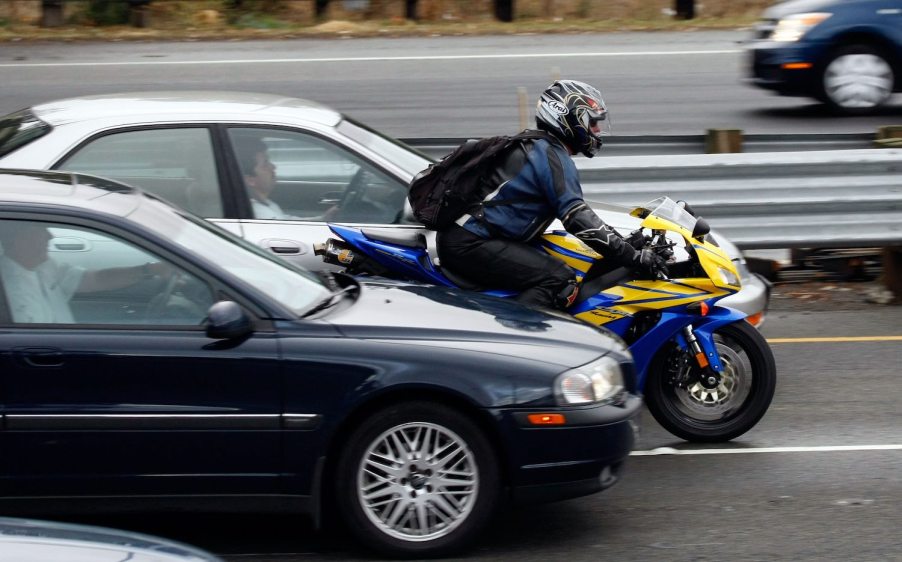
Is It Actually Legal for Motorcycles to Ride Between Lanes of Slow-Moving Cars?
So you were sitting in traffic on the highway the other day, and next thing you knew, a motorcycle was racing between rows of slow-moving cars. You pulled your arm back inside your open window moments before the speed demon blasted past your mirror with inches to spare. And you thought to yourself, How can it actually be legal for motorcycles to ride between cars? If you live in California, this practice (called lane splitting) is legal–within limits. One dozen other states don’t expressly allow lane splitting but don’t prohibit it either.
What is lane splitting?
Lane splitting is when a motorcycle or bicycle rides between two lanes of traffic. Usually, two-wheel travelers do this to avoid being trapped in slow-moving traffic. California has found that the practice can even improve the flow of traffic.

What is lane filtering?
Lane filtering is when a motorcycle rider passes between lanes of cars parked at a red light. The idea behind lane filtering is that once the light turns green, the motorcycle will accelerate away faster than the cars. Not only does filtering up keep the motorcycle rider from getting stuck in slow-moving traffic, but it also helps spread out the vehicles on the road and improve the traffic flow. For this reason, lane filtering is legal in some states where lane splitting is prohibited, such as Utah.
What is shoulder surfing?
Shoulder surfing is a form of lane splitting. In this practice, a motorcycle or bicycle steers onto the shoulder of the road to ride around stopped or slow-moving cars. This can help reduce the amount of congestion during heavy traffic. For this reason, shoulder surfing is actually legal in Hawaii.
Is lane splitting illegal?
Twenty-nine states expressly prohibit lane splitting, so yes, it is illegal in most of the U.S. At the same time, California allows lane splitting, Utah allows lane filtering, and Hawaii allows shoulder surfing. An additional twelve states have no laws allowing these practices but no laws expressly prohibiting them.

In states with no laws expressly prohibiting lane splitting, a police officer could still ticket a lane splitting motorcyclist for reckless driving or a number of other expenses. New Mexico, for example, specifies that you must position your motorcycle somewhere in your lane where everyone can see your turn signals. A lane splitting motorcyclist would be breaking this law.
There are dangers to lane splitting on a motorcycle besides legal ramifications. A recent report concluded that motorcycles lane splitting cause more crashes than motorcycles staying in their own lane. If a motorcyclists are involved in an accident while lane splitting, their insurance provider might not cover any damages or injuries. According to Forbes, in a state where lane splitting is not expressly permitted, a motorcyclist engaging in the practice could be considered “negligent” if any accidents result.
When is lane splitting legal?
Even in California, not every form of lane splitting is legal. The state defines the practice as “A motorcycle ridden between rows of stopped or moving vehicles in the same lane including on both divided and undivided streets, roads, or highways.” (California law AB-51, according to the Motorcycle Legal Foundation).

But California specifies that motorcyclists should only do this if surrounding traffic is moving slowly. It also says motorcycles shouldn’t go more than 10 mph faster than surrounding traffic. Motorcyclists risk being pulled over for dangerous riding if they break these guidelines.
Next, find out every state that allows lane splitting on a motorcycle or learn all about lane splitting from a motorcyclist’s perspective in the video below:







